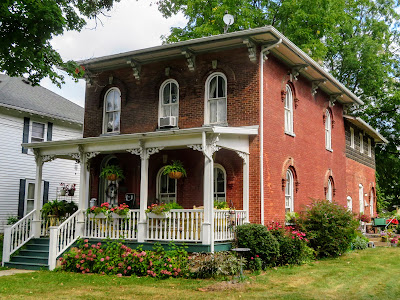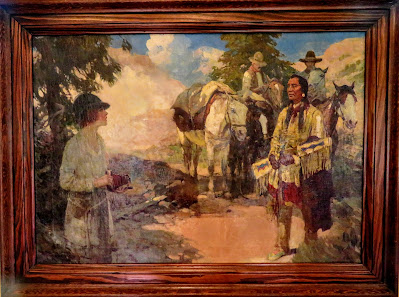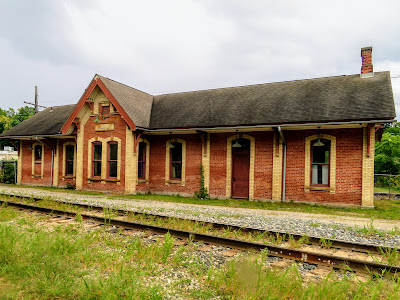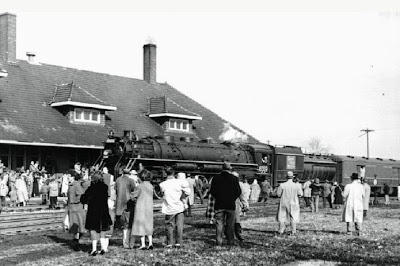We hope that everyone had a great Thanksgiving Holiday. If you don't live in the USA, then we're hoping that you have or have had a great weekend.
…continuing with our late summer road trip to Michigan and beyond. In this post, Laurie and I were with my cousin Nathan and his wife Janice, finishing our exploration of Shiawassee County Michigan and specifically the city of Owosso. We also touched on a couple other historic places closer to their home in Fenton Michigan.
Owosso
has 20 homes separately listed on the National Register of Historic Places as
well as 3 Historic Residential Neighborhoods.
There are another 10 listings on the National Register including 2
commercial districts. With one
exception, we stayed with individual historic homes…
The Nathan Ayres House is located at 604 North Water Street. The style is Italianate and that distinctive 5-sided bay on the front of the home certainly adds architectural interest. Ayres was a brick mason by trade and by 1883 he was well-off enough to build this brick home. Nathan’s daughter, Effie, taught in the Owosso school system for many years and was subsequently promoted to Principal at the city’s Central School.
This is the Benjamin Oliver Williams House. It is located at 628 North Ball Street in Owosso. Benjamin founded Owosso in 1836 with his brother Alfred. The brothers worked to recruit settlers and manufacturers to the area. In 1838, Benjamin built this small L-shaped wood framed Greek revival style house on West Oliver Street. It was moved to Ball Street sometime after 1868. Local craftsman and painter Henry Daniels purchased the home from Williams some time prior to 1876.
The George Pardee House is a bit newer than the previous two as it was built in 1906. George Pardee was one of Owosso’s most successful lawyers. To say that this home at 603 North Ball Street is eclectic might be an understatement. It is Romanesque Revival inspired but it isn’t easily defined. Note the rough-faced poured concrete block façade, the Ionic columns on the porch and then of course, there is that five-sided, three story tower. It’s safe to say that the Pardee home was built to project an image of wealth and success.
Just down the street from the Pardee House, the Leigh Christian House can be found at 622 North Ball Street. Leigh Christian was the son of a successful merchant named Daniel Christian and Leigh was part of the business. He built this mixed styles home in 1895, with architectural elements of Queen Anne and Georgian Revival on display. Leigh eventually became the sole proprietor of the family’s store…changing the retail focus to emphasize apparel and household goods. Leigh and his family eventually moved into his father’s second home, the Goodhue-Christian House which is located in Owosso’s Oliver Street Historic District.
The Christian-Ellis house is located at 600 North Water Street in Owosso. This is the home that Leigh Christian’s father Daniel built for the rest of his family in 1895. In 1885 Daniel had opened a large dry-goods business in town. It was the first real store in Owosso. By the beginning of the 1900s, it had evolved into the city’s first true department store. Looking at the house, one can see some of its Georgian Revival features such as the Doric columns on the porch and the paired rounded arch windows on the second story. But the overall design is best described as transitional…with both Queen Anne and Georgian elements.
When
Daniel Christian moved to his new home in what is now the Oliver Street
Historic District, this house was purchased by J. Edwin Ellis, the President of
the Independent Stove Company which Ellis had moved to Owosso from Detroit in
1908. Ellis became very involved in
Owosso’s social life and he served as the city’s mayor between 1941 and 1947.
This is
the Alfred Williams House. My photo didn't come out well enough to publish, so I captured this one from the Internet. This one and
a half story Greek revival home was built ca. 1840. As you might recall from my notes about the
first house listed in this post, Alfred and his Brother Benjamin were the
founders of Owosso. Alfred started the
first general store in town, the Williams Brothers Trading Post. He also dammed the Shiawassee River in 1836
and had a millrace built to channel the water power and establish the town’s
first mills. Initially this home was on
Oliver Street and it was moved to 611 North Ball Street ca. 1900.
This 2-story, 3-bay brick Italianate home was built by Herman Frieseke in 1870. Herman and his brother Julius operated a local brickyard which became quite profitable. The front porch of the home has been altered and that ugly large concrete block addition at the back of the home certainly detracts from the home’s appearance.
The house
is not known as the Hermann Frieseke House but rather as the Frederick Frieseke
Birthplace and Boyhood Home. Frederick was
born here in 1874. At a young age he
showed quite an aptitude for art and, after elementary school, his parents sent
him to the Art Institute of Chicago for further training.
The first painting shown above is a self-protrait by Frederick Frieske and the second one ia titled "Girl in Blue Arranging Flowers" and he painted it in 1915. After finishing his studies at the Art Institute of Chicago, Frederick moved to Paris where he studied under Whistler. Frederick was an impressionistic painter who spent most of his life in France where he was an influential member of the Giverny Art Colony. He is especially known for painting female subjects, both indoors and out. He was awarded the Chevalier of the Legion of Honor, the highest honor bestowed on artists by the French government.
Frederick
Frieseke’s paintings are owned by many and varied art museums, both in the USA
and abroad. Examples include the Art
Institute of Chicago, Metropolitan Museum of Art in New York City, the Museum
of Fine Arts in Boston and the St. Louis Missouri Art Museum. In Washington D.C. his works are on display
at the Corcoran Museum of Art, the Hirshhorn Museum, the National Gallery and
the Smithsonian American Art Museum. His
works sell for between $20 and $300 thousand dollars each. To learn more about the artist and to view a
variety of his paintings, just go to https://en.wikipedia.org/wiki/Frederick_Carl_Frieseke.
The Elias Comstock Cabin is located at the corner of Curwood Castle Drive and John Street in Owosso. That's Laurie standing at the front door waving at me. Built in 1836, this 20’ by 30’ one-room cabin is the oldest residence that is still standing in the city. I love that stonework at and around the hearth.
Elias was born in New London Connecticut in 1799. In 1824, he moved to Michigan with his parents. He taught school and in 1835 he moved to the newly established community of Owosso. He was the city’s first real settler. He was a successful merchant and in 1837 Governor Lewis Cass appointed Elias as the county’s Justice of the Peace. Over the years, he also served as the Township’s Supervisor, a Judge of Probate, County Judge and Associate Judge of the Circuit Court.
Over
time, the Comstock family added a series of frame additions to the house. Eventually, that single room cabin became the
living room and it was completely covered by a frame exterior. In 1890, the home passed on to the first of
two other families. But in 1920, the
Standard Oil Company bought the property and began demolition of the house…only
to discover the old log cabin preserved inside.
The Daughters of the American Revolution then led an effort to preserve
the cabin and in 1969 it was moved to its current site.
Yes indeed, it is a small castle! Curwood Castle was built along the banks of the Shiawassee River by author James Oliver Curwood in 1923 and 1924. It is a romantic version of a Norman Chateau. Curwood used this as a place to greet guests and as a writing studio in his hometown of Owosso. He actually lived nearby with his family on the other side of the river. The exterior of the castle is made of yellow stucco which contains decorative, randomly placed fieldstones that Curwood chose himself.
The photos shown above are intended to give you an idea of what the interior of Curwood Castle looks like. There are 3 levels in total but I wasn’t going to climb those steep narrow spiral staircases. The first interior photo almost looks like a hunting lodge…deceptive in that in his later years, Curwood became a zealous conservationist. I included that painting just because I liked it…
After his
death in August of 1927, his will bequeathed the Castle to the City of
Owosso. Currently it is a museum
operated by the city. Each year the city
hosts the Curwood Festival to celebrate the life and works of James Oliver
Curwood. (1878 – 1927)
So why the fuss over an author that most of us have never heard of? James Curwood spent much of his early life out of doors, touring the south on a bicycle at a young age. He attended the University of Michigan for a couple of years and then went to work as a reporter and later, as an editor at the Detroit Tribune Newspaper. But in 1907, he returned to Owosso to focus on writing and int 1908, he published his first novel.
Curwood
was an action-adventure writer. Many of
his books are based on adventures in the Hudson Bay area of Canada, the Yukon
or Alaska. In total he published 28
adventure/nature novels, 2 collections of short stories and 3 other books, one
an autobiography. At least 180 movies
have been based on or directly inspired by his novels and short stories. James Curwood became quite wealthy as an
author and at the time of his death he was the highest paid author (per word)
in the world. Old timers and movie buffs
may know some of the actors who appeared in the movies made after the silent
film era. They include Lon Chaney, Boris
Karloff, Charles Bickford, Rin Tin Tin (1, 2 and 3), Ann Sheridan, John Wayne,
Rock Hudson, Buster Keaton, Hugh O’Brien, Neve Campbell (in 1995) and American
Olympic hero Jim Thorpe. And then there
was Lois Maxwell, who was “Miss Moneypenny” in the first 14 James Bond movies. To learn more about James Oliver Curwood, you
can go to https://en.wikipedia.org/wiki/James_Oliver_Curwood.
Moving on
from Owosso and Shiawassee County…
Our next stop was in Fenton Michigan. The Fenton Railroad Depot is located at 207 Silver Lake Road and it’s been on the National Register of Historic Places since 1983. William Fenton and Robert Leroy founded Fentonville because they believed that a proposed railroad line would run through the settlement and in 1856, the Detroit, Grand Haven and Milwaukee did just that…
The new
brick depot was built in 1882 replacing an earlier wood structure that burned
down. The new depot served as built
until 1923 when a fire destroyed its roof.
The roof was rebuilt to make the depot as it is seen today. The depot served the railroad until 1974 when
it was purchased by the City of Fenton.
Today it serves as offices for Southern Lakes Parks and Recreation. The interior of the building remains intact…
Our last stop for the day was in the city of Holly in Oakland County Michigan. Holly’s Union Depot was completed in 1886 to replace a wood frame depot that had burned down. This depot was built by the Detroit, Grand Haven and Milwaukee Railroad to serve as a Union/shared depot for that line as well as the Flint and Pere Marquette which intersected here. This late Victorian style depot served as Holly’s railroad passenger station for 80 years. It appears to be deserted at this point in time.
Holly’s
first white settler arrived in 1831 and the town was incorporated in 1838. The village was initially called Algerville
and then Holly Mills. The real growth of
the town began with the arrival of the railroad. The interior of this new depot was paneled
with Norway pine. Each railroad had
their own ticket booth and the depot had 2 waiting rooms, one for women only
and the other with a lunch counter…an unusual feature for a small-town
depot. However since the station served
2 different railroads and had many transferring passengers, the lunch counter
could thrive. At the height of the
railroad era, it was common for over 100 trains per day to pass through
Holly.
I found this old photo on line which shows the Holly Union Depot with a Grand Trunk Western passenger train dropping off and picking up passengers. It isn’t clear how long this depot served the Flint and Pere Marquette Railroad and its successors but it served rail passenger traffic on the Grand Trunk Western until about 1964.
Of
special note, it was at this depot in 1908, that prohibitionist and axe
wielding Carry Nation arrived via train on her crusade against “demon”
rum. That fact ties nicely into the
history of the last historic building that we photographed during our day of
exploration.
The Holly Hotel was first known as the Hirst Hotel. Located at 110 Battle Alley in Holly Michigan, this Queen Anne style hotel was built in 1891 by John Hirst in order to cater to the heavy flow of railroad passengers passing through the town. With the finest and largest dining room in the area, the hotel rapidly became the social center of the community. Joseph Allen purchased the hotel in 1912 and renamed it the Holly Inn. In 1913, a disastrous fire destroyed the second and third floors. Allen immediately rebuilt the hotel but in a more modest style. He renamed it the “Allendorf Hotel”, a take-off on the name of the Waldorf Astoria Hotel in New York City.
But in
1978, the hotel suffered another destructive fire. This time a local resident bought the
building and restored it, rebuilding the roof and tower to the original 1891
design. The building reopened as a fine
restaurant in 1979 and every state governor since that time has dined here…as
did President George H.W. Bush in 1992.
However, on June 21, 2022, fire destroyed multiple other buildings in
downtown Holly, and the Hotel Holly again suffered significant damage. It is scheduled to reopen in the summer of
2023.
Prohibitionist Carry Nation arrived in Holly on August 29, 1908. The Hotel gained significant notoriety when axe wielding Carry and her Pro-Temperance supporters invaded the hotel. Carry began smashing whisky bottles with her ax and her supporters attacked bar patrons with their umbrellas. The owner of the hotel had Carry arrested… It had to be quite a crazy scene! In recent times, the Holly Hotel celebrates Carry Nation’s visit every years with special menus, a re-enactment of her visit…and best of all, special reduced prices on alcoholic beverages.
This is an early photo of the Hotel. This was taken after the fire in 1913 when the hotel had been rebuilt more in a more modest style and before it was once again rebuilt in 1978 to resemble in the original 1891 building.
For those of you who are into ghosts and hauntings, the Holly Hotel is the place for you! Among the spirits are Mr. Hirst himself, Nora Kane, the Ghost in the Kitchen…perhaps a little girl, Leona, the Hirst’s dog and a “mysterious Native American”. Plenty of disembodied voices, Nora Kane’s perfume, Mr. Hirst’s cigar smell and more have been noted. Fun times for true believers in the spirit world! You can check out the Holly Hotel when it reopens this coming summer.
Just
click on any of the photos to enlarge them…
Thanks
for stopping by and checking out my blog site!
Take
Care, Big Daddy Dave






















































